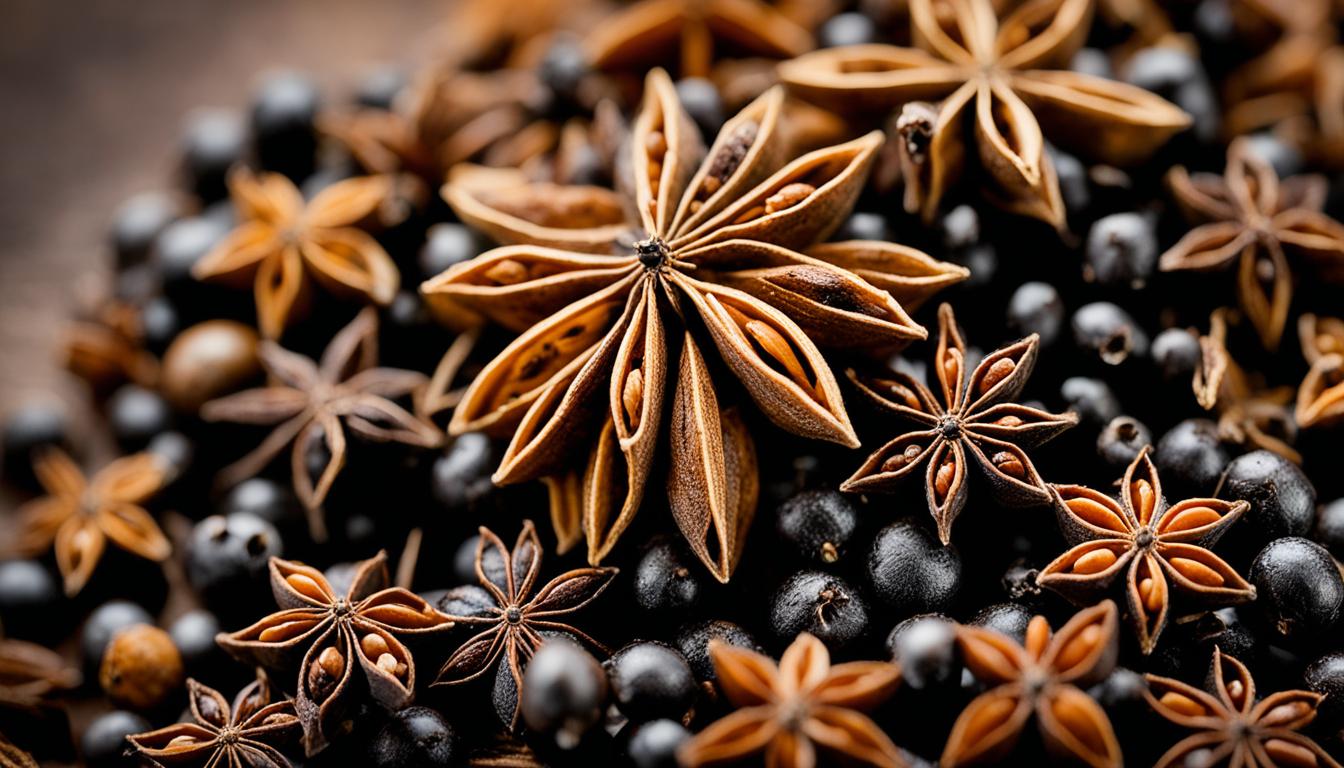I love cooking and exploring aromatic herbs. Anise (Pimpinella anisum) is one spice that always catches my eye. It’s known for its licorice flavor and has been a key spice for centuries.
Its unique smell and taste can change many foods. It makes baked goods, pickles, liqueurs, and savory dishes special.
Anise has a deep history and is important in many cultures. People have used its seeds, leaves, and flowers for health and cooking for a long time. This shows how versatile and adaptable anise is.
Exploring anise has shown me many ways to use it in cooking. It adds a special licorice flavor to sweets and a unique taste to pickles and liqueurs. I’m excited to learn more about its health benefits too.
Exploring the World of Anise Flavors
I love cooking and the smell of anise always catches my attention. It has a long history, dating back to ancient times. People used it for both cooking and medicine. But what makes anise taste so unique, and how does it compare to other spices?
Chemistry Behind the Licorice-Like Taste
Anise’s flavor comes from certain chemicals. These include (E)-anethole and estragole. You can find these in fennel, tarragon, and basil too. They can often be swapped with anise in recipes.
Different plants have different amounts of these chemicals. This affects their taste. Anise has a strong licorice flavor. Fennel is sweeter and milder.
| Herb/Spice | Primary Flavor Compounds | Flavor Profile |
|---|---|---|
| Anise | (E)-anethole, estragole | Pronounced, assertive licorice-like taste |
| Fennel | (E)-anethole, estragole | Milder, sweeter licorice-like notes |
| Tarragon | (E)-anethole, estragole | Subtle, herbaceous licorice undertones |
| Basil | (E)-anethole, estragole | Slight licorice-like flavor, more herbaceous |
Knowing how anise and other spices are similar helps us enjoy their flavors more. We can use this knowledge to make our dishes better.
Anise: The Powerful Licorice-Scented Spice
Anise seeds have a strong licorice smell and taste. They make many foods taste better. They are used in sweet and savory dishes. Anise adds a special licorice flavor to food.
In baking, anise seeds are a key ingredient in treats like biscotti and cakes. They mix well with sweet foods, making them taste great. Anise also goes in savory dishes, adding flavor to sauces and meat.
Anise is important in making liqueurs like ouzo and pastis. These drinks get their unique taste from anise seeds. Anise is stronger than fennel seeds, making it a bold choice for cooking.
| Culinary Uses of Anise | Examples |
|---|---|
| Baking and Cooking | Biscotti, pizzelle, cakes, marinara sauces, meat dishes, pickling brines |
| Liqueurs and Cordials | Ouzo, pastis, sambuca |
Anise adds a special licorice flavor to both sweet and savory dishes. It’s a great spice to have in your kitchen.
Anise Hyssop: A Unique Herbal Twist
Anise hyssop (Agastache foeniculum) is a special herb in the mint family. It has a sweet licorice flavor, just like the spice anise. This herb adds a unique taste to many dishes.
Flavor Profile and Culinary Uses
Anise hyssop’s leaves and flowers have a sweet anise taste. They also have hints of basil and tarragon. This makes it a great addition to many recipes.
- Infuse vinegars and syrups for a touch of licorice-scented sweetness
- Garnish salads, drinks, and desserts for a visually appealing and flavorful twist
- Incorporate into baked goods like cookies, cakes, and breads for a distinctive aroma
- Add to savory dishes such as roasted meats, stews, and sauces for a complex, licorice-like accent
Anise hyssop is not the same as true anise but has a similar flavor. It adds a unique taste to many dishes. It’s a great choice for those who love to try new things in the kitchen.
| Characteristic | Description |
|---|---|
| Botanical Name | Agastache foeniculum |
| Plant Family | Lamiaceae (Mint Family) |
| Aroma and Flavor | Sweet, licorice-like with hints of basil and tarragon |
| Key Flavor Compounds | Estragole, limonene, (E)-ocimene |
| Culinary Uses | Infusions, garnishes, baked goods, savory dishes |
Basil: More Than Just a Hint of Licorice
Basil is a favorite herb known for its fresh taste and smell. Many types of basil also have a hint of licorice or anise. This comes from compounds like estragole and linalool. This makes basil great for many dishes.
Thai basil is one type with a strong spice and anise taste. This flavor lets basil work well in sweet and savory dishes. It’s perfect for pesto, salads, baked goods, and even cocktails.
Exploring the Basil Flavor Profile
Basil’s taste comes from different compounds:
- Estragole: Adds a licorice-like taste
- Linalool: Gives it a floral and sweet touch
- Myrcene: Creates a green, herb-like smell
These compounds mix to make basil’s unique flavor. This makes it very useful in cooking.
Culinary Uses of Basil
Basil’s flavor is great for many dishes:
- Pesto: It goes well with pine nuts and Parmesan cheese.
- Salads: Basil adds fresh flavor and aroma to salads.
- Baked Goods: It can make breads, pastries, and desserts taste better.
- Cocktails: Basil adds a unique twist to drinks.
Using basil’s complex flavor can open up new cooking possibilities. Both home cooks and chefs can explore new dishes.
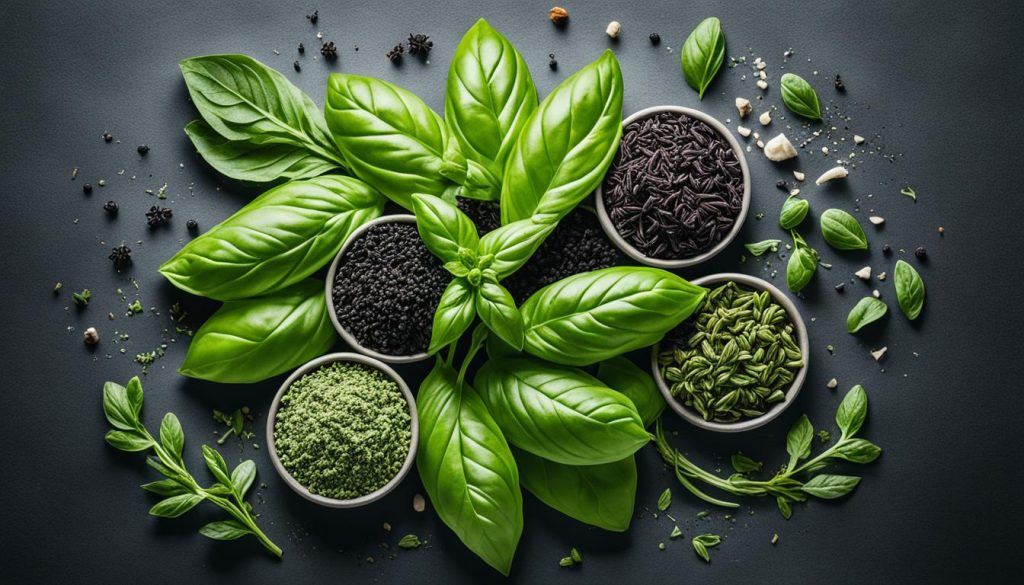
“Basil’s licorice-like notes add a unique depth of flavor that can elevate a wide range of dishes, from savory to sweet.”
Chervil: A Delicate Tarragon-Parsley Blend
Chervil is a hidden gem in the herb world. It tastes like a mix of tarragon and parsley. This herb, known as Anthriscus cerefolium, has a sweet, pear-like flavor with a hint of licorice.
Chervil’s unique taste comes from its chemical makeup. It has estragole, like tarragon, which gives it licorice-like notes. It also has green, herbal flavors like parsley. This mix of tastes is both delicate and interesting.
Chervil may not taste strongly of licorice like some herbs. But it has many uses in cooking. It adds a subtle, aromatic touch to dishes like sauces, soups, egg dishes, and salads. Its gentle flavor enhances other ingredients without taking over.
“Chervil’s flavor is often described as a refined blend of tarragon and parsley, with a subtle, sweet, and slightly pear-like quality.”
When you want to add elegance to your cooking, try chervil. Its licorice-tinged flavor and delicate taste can make simple dishes special.
Dill: Pungent Undertones of Anise
Dill (Anethum graveolens) is an herb with a unique smell and taste. It has a strong taste like anise. The leaves, flowers, and seeds have compounds like carvone, limonene, and dill apiole. These give it a complex, slightly bitter flavor.
It’s not as strong as anise or fennel but has a subtle anise taste. This makes dill great for both sweet and savory dishes.
Culinary Versatility of Dill
Dill is a key ingredient in pickles and preserves, adding a special aroma. It also makes sauces, soups, and egg dishes taste better. Dill can be used with many foods, like meats, seafood, grains, and vegetables.
| Flavor Profile | Chemical Compounds | Culinary Applications |
|---|---|---|
| Pungent, anise-like undertones | Carvone, limonene, dill apiole | Pickles, preserves, sauces, soups, egg dishes, meats, seafood, grains, vegetables |
The anise taste in dill makes it great for many dishes. It’s used in savory dishes and pickles and preserves. The dill flavor profile comes from its chemical compounds in the leaves, flowers, and seeds.
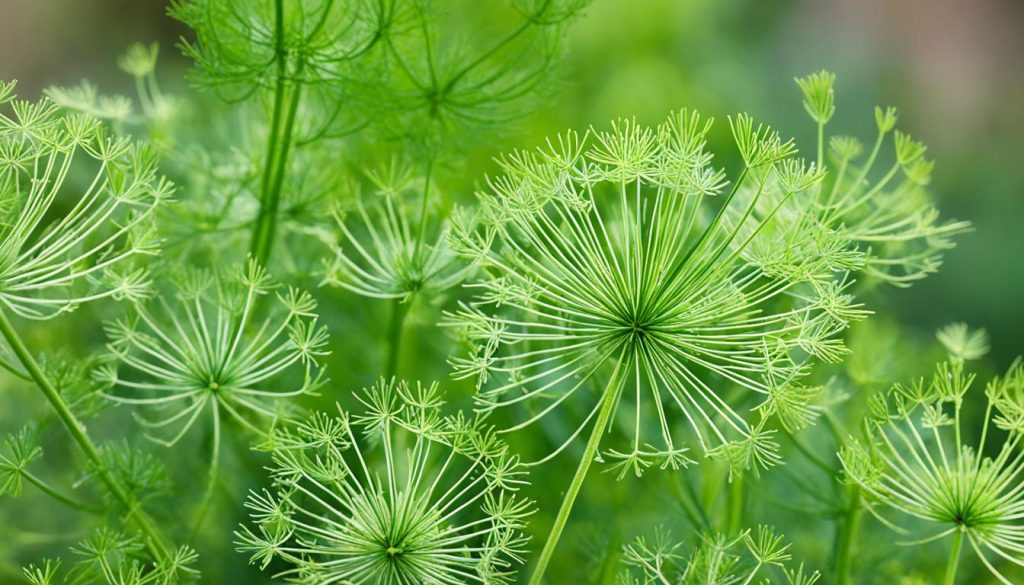
“Dill is a classic component in pickles and preserves, where its aromatic qualities complement the brine.”
Fennel: The Earthy, Sweet Anise Cousin
Fennel (Foeniculum vulgare) is a special plant in the carrot family, like anise. It has a flavor that mixes earthy sweetness with a hint of licorice smell.
Fennel’s special taste comes from its chemical makeup. Its leaves, flowers, and seeds have compounds like (E)-anethole, estragole, and fenchone. These give it a unique flavor. Fennel tastes milder than anise, with less licorice flavor.
Fennel is great in many dishes. You can find it in baked goods, pickles, soups, stews, and roasted veggies. It makes many foods taste better.
| Characteristic | Fennel | Anise |
|---|---|---|
| Flavor Profile | Earthy, sweet, and mellow | Pronounced licorice notes |
| Key Compounds | (E)-anethole, estragole, fenchone | (E)-anethole, trans-anethole |
| Culinary Uses | Baked goods, pickles, soups, stews, roasted vegetables | Baked goods, liqueurs, teas, spice blends |
“Fennel is a versatile ingredient that can add depth and complexity to a wide range of dishes. Its unique aromatic profile makes it a must-have in any well-stocked kitchen.”
French Tarragon: The Classic Anise Flavor
I love cooking and exploring flavors. French tarragon (Artemisia dracunculus ‘Sativa’) has always caught my eye. It’s from Central Asia and known for its unique licorice taste. This taste makes it perfect for many dishes.
What makes tarragon special is its estragole. This is also found in anise and other herbs with a similar taste. Estragole gives tarragon its licorice flavor and a unique kick.
Tongue-Tingling Sensation of Tarragon
Tarragon is not just about taste. It also has a special effect on your tongue. When you eat it, you might feel a slight tingling. This is thanks to a compound called cis-pellitorine.
This unique feeling makes tarragon popular in French and European cooking. It’s used in many dishes, like sauces, vinaigrettes, chicken, and fish. French tarragon adds a special touch to your food.
Whether you’re making Béarnaise sauce, flavored vinegar, or just adding it to veggies, tarragon is key. It brings a anise-like magic to your dishes.
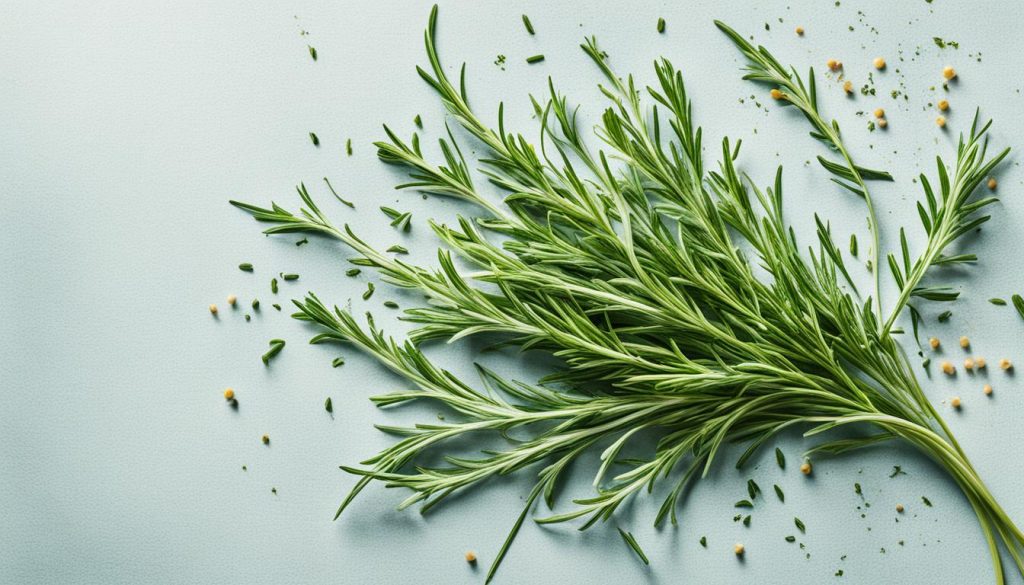
“Tarragon is the herb that defines French cuisine. Its licorice-like aroma and flavor are unparalleled, making it a staple in countless savory dishes.”
Licorice Root: The Real Deal
Many herbs and spices taste like licorice, but licorice root (Glycyrrhiza glabra) is the true deal. It has a sweet taste, up to 150 times sweeter than sugar. Unlike other herbs, it tastes mainly sweet.
For centuries, people have used licorice root in medicine. It’s also in many foods, drinks, and sweets. Its sweet taste comes from glycerrhizin, a special compound.
Culinary Uses of Licorice Root
Licorice root is not just for medicine. It’s used in many foods too. You can find it in candies, liqueurs, and teas. It also flavors baked goods and some savory dishes, adding a unique taste.
Health Benefits of Licorice Root
Studies show licorice root has health perks. It can fight inflammation and viruses. It might help with digestion and boost the immune system. But, talk to a doctor before using it, as it can affect some medicines.
| Compound | Percentage in Licorice Root | Attributed Properties |
|---|---|---|
| Glycyrrhizin | 4-20% | Intense sweetness, anti-inflammatory, antiviral |
| Flavonoids | 2-6% | Antioxidant, antimicrobial |
| Saponins | 1-9% | Emulsifying, foaming, expectorant properties |
“Licorice root has been used as a natural sweetener and herbal remedy for thousands of years, and its distinctive flavor profile continues to captivate culinary enthusiasts and health-conscious consumers alike.”
Mexican Tarragon: A Pungent Anise Alternative
I love exploring the world of herbs and their unique tastes. Mexican tarragon caught my eye because it’s different from the French kind. It has a bold, pungent flavor.
Mexican tarragon is also called sweet marigold or Mexican mint marigold. It has a licorice-like aroma and flavor that’s unique. It has compounds like estragole and (E)-anethole that give it an anise-tinged taste. It’s more assertive than French tarragon, with minty hints and a bit of bitterness.
I like Mexican tarragon because it’s so versatile. It’s a great alternative to French tarragon. You can use it on meats, vegetables, and even in vinegars and drinks. Its anise-forward character makes dishes more interesting.
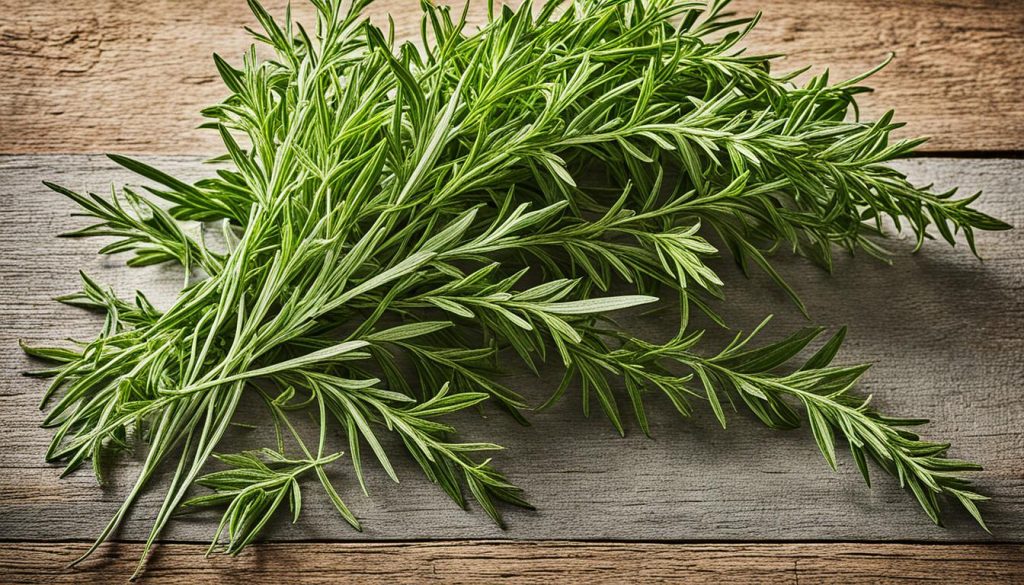
If you’re a chef or a home cook, exploring Mexican tarragon is exciting. It has a pungent, anise-like flavor and many uses in cooking. This herb can change up your dishes with its unique taste.
Licorice-Flavored Herbs: A Diverse Flavor Palette
The world of anise-flavored herbs is full of variety. Many plants from different families have their own special licorice flavor. From the strong taste of anise and fennel to the light taste of chervil and Mexican tarragon, these herbs add flavor to many dishes.
These licorice-flavored herbs are not just for cooking. They also have health benefits because they fight off germs and protect against harm. By learning about these plants, cooks can make new and tasty dishes.
If you want to add a licorice flavor to your food or try the health benefits of these herbs, anise-flavored herbs are a great choice. They open up new ways to cook and enjoy food.

